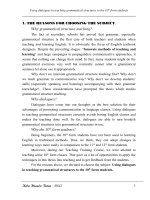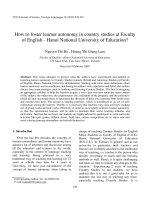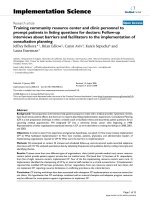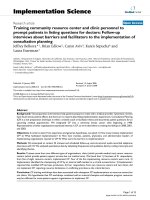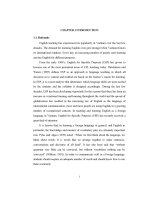Incorporating multiple intelligences into follow up activities in teaching American literature to the 4th-year students at faculty of English, Hanoi national university of
Bạn đang xem bản rút gọn của tài liệu. Xem và tải ngay bản đầy đủ của tài liệu tại đây (5.72 MB, 6 trang )
JOURNAL OF SCIENCE OF HNUE
2013, Vol. 58, No. 6B, pp. 12-17
This paper is available online at
INCORPORATING MULTIPLE INTELLIGENCES
INTO FOLLOW-UP ACTIVITIES IN TEACHING AMERICAN LITERATURE
TO THE 4TH-YEAR STUDENTS AT FACULTY OF ENGLISH,
HANOI NATIONAL UNIVERSITY OF EDUCATION
Do Thi Phuong Mai
Faculty of English, Hanoi National University of Education
Abstract. The author investigated the possibility of incorporating multiple
intelligences into post-reading activities in teaching American Literature to senior
English language majors studying at the Hanoi National University of Education.
The research consisted of a time period in a Literature class which begins by
introducing the short story, “The Story of an Hour.” A follow-up assignment was
given Following a variety of while-reading exercises, a follow-up assignment was
given that required the students to reveal what they understood about the text,
which helps the teacher access their levels of comprehension. The result indicated
that incorporating such ‘multiple intelligences’ in this way enabled the students to
interact with the literary work and at the same time raised their confidence and
interest in exploring the text.
Keywords: MIs, post reading activities, American Literature.
1. Introduction
An American Literature course was designed for fourth year students in their 7th
semester of an eight semester ELT course. It was a fifteen-week course which provided
students with an overall view of American literature that was to provide basic information
on its development, factors that affected this development, some major trends, and certain
prominent American writers that represent different stages and trends in literature.
While desiring to increase English major students’ proficiency in English and
encourage them to read more, the syllabus developers also expected that the selected texts
would lead to personal development and encourage an appreciation of creative language.
The fulfilment of these goals would result in an integration of cultural, language and
personal growth models of teaching literature (Carter, R & Long, M. 1991) and would not
Received July 29, 2013. Accepted September 12, 2013.
Contact Do Thi Phuong Mai, e-mail address:
12
Incorporating multiple intelligences into follow-up activities in teaching American Literature...
only improve language proficiency but would also enable students to make a connection
between the texts and their personal lives. Literature is, therefore, viewed as a source
of facts or information and the literary text as a product (Sidhu, 2003.) However, there
arose a problem, and that was the emphasis the examination placed on language learning.
Additionally, English language teachers usually do not encourage students to interact
and respond to the texts, purportedly because students have different levels of language
proficiency and different aptitudes. Therefore, reinforcement and follow-up activities are
essential.
2. Content
2.1. The sample - “The story of an Hour” by Kate Chopin
The story is about an hour in the life of the main character, Mrs. Mallard. Mallard is
a woman who is afflicted with a heart problem. That is the reason why her sister Josephine
and Richard, her husband’s friend, broke the news of her husband’s death to her as gently
as possible. Surprisingly, Mrs. Mallard reacts to the news with excitement. Even though
it was thought that the news would be heartbreaking she feels that she is finally free from
the depressing life she was living. She is happy because she doesn’t have to live for anyone
but herself now. Unfortunately, her husband, Mr. Mallard, is still alive and knows nothing
about the supposed accident. When the husband did come home, Richard tried to block
Mr. Mallard’s view of his wife but they could not. The doctors told Mr. Mallard that his
wife died of a heart attack, "of a joy that killed her."
When I first introduced the story to my students, it got a very enthusiastic response
from students of all English language proficiency levels due to the appealing theme and
its short length. Thus, despite the fairly wide variation in language proficiency among the
students, the warm up activities, which included brainstorming for possible meanings and
interpretation of the terms and phrases, managed to elicit a wide range of spontaneous
responses from the students. The warm up and following sessions facilitated the students’
general comprehension, familiarized them with difficult words and gave them an insight
into the possibilities of the story. The questions and comments they made reflected their
interest in the story. In order to allow every student an opportunity to interact with the
story in a way that was most meaningful to them, I drew upon the concept of multiple
intelligences (Howard Gardner, 1983) which proposes that students will benefit more from
a more diverse vision of education and the use of different methodologies, exercises and
activities as a framework for post-reading activities.
As a follow-up activity, students were given the assignment of interpreting the story
any way they wanted, either in groups or as an individual activity. Suggestions were made
to help students have some idea about what they were expected to do. They were given
one week to prepare their presentation.
2.2. Results and discussion
Visual representation
13
Do Thi Phuong Mai
Group 1’s pictures
Group 2’s pictures
Two groups of students, with four members each, visualized the story in the way
they think it should happen. As their teacher I realized that these students were limited
in their verbal linguistic skills, and it could be said that they were ‘slow learners’. Even
if they found it difficult to express themselves verbally they could still understand what
was happening in the story and relate to it. Perhaps the visual representation was over
simplistic; however, it did mean something important to the artist. In this case, their visual
intelligence far exceeds any other type of intelligence they might exhibit.
14
Incorporating multiple intelligences into follow-up activities in teaching American Literature...
The journals
About one fourth of the students chose to make journal entry responses to the story.
Of these, most had a higher level of English language proficiency than the others and they
occasionally wrote their thoughts and reflections in their own diaries, too.
The following are extracts from two of these journals, written in English.
Extract 1
What a great story! When I first read it, I feel sad because the woman has just lost
her husband. Then I feel astonished but excited and happy when she starts to say "Free!"
thinking of all the things she is going to do now that she does not have a husband that
prevents her from doing things. And finally when she gets out of the room to express her
happiness, her husband is at the door and alive and she dies.How ironic it is! It is like
a person just won the lottery prize and after he screamed and jumped of excitement he
really realized that he didn’t win in fact.
Extract 2
Reading the story, I have a feeling that Mrs. Mallard is like a person who was “dead”
long before her physical death. Her physical death was described as “the joy that kills.”
What’s about her so-called “real” death? When hearing that her husband was dead, she
celebrated her new life. The scene in which she was living prior to learning about her
husband’s “death” could not have been thought of as really living. If her sole desire was
to be free of her marriage, which is supposedly lifelong, then what type of life was she
truly living?
The journals reflected intrapersonal intelligence, which involves introspective
and self-reflective capacities. Multiple Intelligences theory categorizes people with
intrapersonal intelligence as intuitive and typically introverted and skilful at deciphering
their own feelings and motivations. Although the students who had chosen to do the
journal entries were not typically introverted, they were the ones in the class who usually
wrote essays that reflected a deeper understanding of the self and their own emotional
reactions.
Found poem
One group of five students summarized the story and then they wrote a prose
passage and underlined words and phrases that struck their interest or that related to the
theme of the passage.
After that was written, with the help of the teacher they took these images and
"found" a poem. They were free to add new words or change words if they seemed
cumbersome, but the base of the poem was the actual words and phrases from the original
text.
The poem reflected the students’ verbal/ linguistic intelligence and their interest in
literature as well.
Here is the poem:
Brently Mallard’s name Leading the list of killed In a railroad disaster Hearing the
15
Do Thi Phuong Mai
news She wept at once Went to her room alone Facing the open window, a roomy armchair
She sank, Then sat motionless There was a dull stare in her eyes And an intelligent thought
What was it? “Free, free, free” Absolutely Free! Body and soul A long procession of years
to come Would belong to herself And she carried herself Like a goddess of Victory
Drama
One group chose to do a small drama based on the story. It was a seven-minute play
with the main character being Mrs. Mallard since she heard the news of her husband’s
death. This form of genre adaptation involved Gardner’s Interpersonal-linguistic
intelligence, which has to do with interaction with others. The drama added another
dimension to the story and the creation of characters, script and setting seemed to bring it
to life in the language classroom. The students seemed to be great actors and actresses!
Mind-mapping and Timeline
One group of students drew a timeline of the story; all the main events in the story
are given in a logical and easy-to-understand way. This group of students seemed to be
logical in their thinking and illustrated their ideas very clearly.
Setting
Time and place: At the
Mallard house
Characters:
Mrs. Louise Mallard
Mr. Brent Mallard
Josephine – Louise’s sister
Richard – Mr. Mallard’s friend
Chain of events
The beginning events that
initiate the actions
Internal response and goal/
problem
Attempts and outcome
Climax
Resolution
Mrs. Mallard has heart trouble but she survives when
hearing the news of her husband’s death.
She cries a lot and wants to be by herself in a locked
room.
While alone, she does some thinking and she knows
that she’s happy when her husband dies, because now
she’s free “body and soul” to live for herself.
As soon as she leaves the room, she sees her husband
and she is deeply shocked.
Mrs. Mallard dies.
3. Conclusion
The idea of incorporating multiple intelligences into follow-up activities in the EFL
literature classroom brought many interesting results. First, despite the fact that there
was a lot of overlapping among the different ‘intelligences’, students generally chose
to interpret the story in the way they felt most comfortable and best at doing. Each of
16
Incorporating multiple intelligences into follow-up activities in teaching American Literature...
them had a personal entry point into the story and for many this proved to be a first-time
experience of interacting with a literary text on their own terms. This also gave them
a sense of empowerment and helped build confidence and enthusiasm to explore other
texts. It provided even students with very limited language proficiency with an avenue to
enjoy and appreciate literary texts that might previously have seemed unattainable . As the
language teacher, I recognized that if students are unable to express themselves eloquently
through words alone, they may be quite confident in exploring the text in other ways.
REFERENCES
[1] Beach, Richard, 1993. A Teacher’s Introduction to Reader Response Theories.
Urbana, IL: National Council of Teachers of English.
[2] Carter, R & Long, M., 1991. Teaching Literature. Longman
[3] Gardner, Howard, 1999. Intelligence Reframed: Multiple Intelligences for the 21st
Century. New York: Basic Books
[4] Glasgow, 1997. Utilizing our Multiple Intelligences Reader Response Activities.
Battlecreek 103.weekly.com
[5] Holland, N, 1968. The Dynamics of Literary Response. Oxford University Press.
[6] Rosenblatt, L. M, 1938, 1978. Literature as exploration. New York: Aplleton Century
[7] Rosenblatt, L. M, 1938, 1978. The reader, the text, the poem: The transactional theory
of the literary work. Carbondale and Edwardsville: Southern Illinois University Press.
[8] Sidhu,G.K, 2003. Literature in the Language Classroom: Seeing through the eyes
of learners. In Ganakumaran Subramaniam (ed.), Teaching literature in ESL/EFL
contexts, Petaling Jaya: Sasbadi.
17




